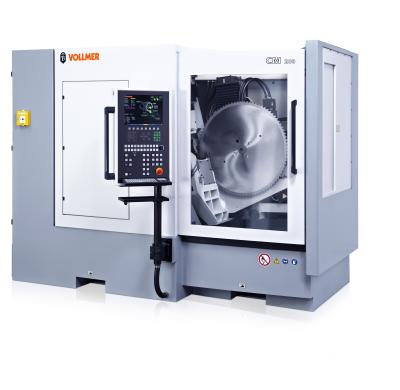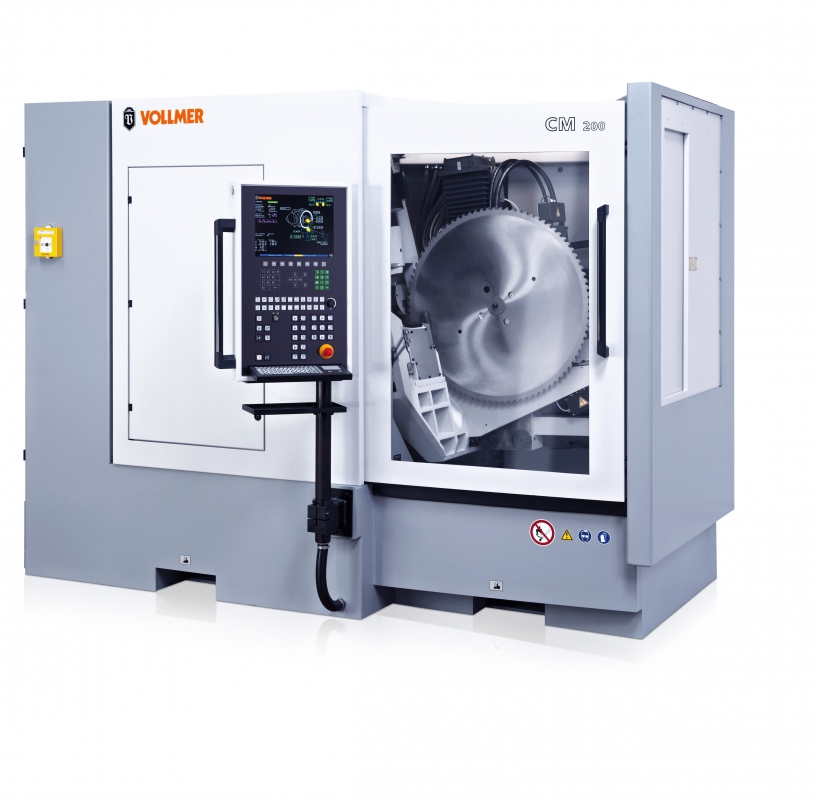
 The use of carbide- or cermet-tipped thin-kerf metal circular saws allows for high feed rates, low machining forces and thin saw kerfs—all of which reduces energy consumption and saves resources, according to Vollmer of America, which specializes in grinding and erosion machines, and develops sharpening machines such as the CM 200/300 and the CMF 200/300.
The use of carbide- or cermet-tipped thin-kerf metal circular saws allows for high feed rates, low machining forces and thin saw kerfs—all of which reduces energy consumption and saves resources, according to Vollmer of America, which specializes in grinding and erosion machines, and develops sharpening machines such as the CM 200/300 and the CMF 200/300.
The production of thin-kerf metal circular saws presents manufacturers with significant challenges in terms of precision and stiffness, however. Not only must different cutting materials, such as carbides or cermet, be sharpened, but a variety of cutting geometries must also be machined, depending on the application. Vollmer has developed various sharpening machines, such as the CM 200/300 and the CMF 200/300, specially for sharpening these kinds of circular saws. These two machines can be used to machine the hook and clearance angles, as well as the sides of the teeth. The fixed grinding unit and the solid construction of the CM and CMF series permit a high level of stiffness to be achieved for precision grinding. As a result, saw manufacturers can attain an optimized surface finish and dimensional accuracy for circular saws. Set-up and measurement compensation are automatic on Vollmer's sharpening machines, which provides a high level of process stability.
Thanks to the nine CNC-controlled axes, carbide-tipped thin-kerf metal circular saws can be sharpened without having to be clamped in more than one position. The handling system and loading carriage together allow machining to continue unsupervised around the clock.
Contact Details
Related Glossary Terms
- clearance
clearance
Space provided behind a tool’s land or relief to prevent rubbing and subsequent premature deterioration of the tool. See land; relief.
- feed
feed
Rate of change of position of the tool as a whole, relative to the workpiece while cutting.
- grinding
grinding
Machining operation in which material is removed from the workpiece by a powered abrasive wheel, stone, belt, paste, sheet, compound, slurry, etc. Takes various forms: surface grinding (creates flat and/or squared surfaces); cylindrical grinding (for external cylindrical and tapered shapes, fillets, undercuts, etc.); centerless grinding; chamfering; thread and form grinding; tool and cutter grinding; offhand grinding; lapping and polishing (grinding with extremely fine grits to create ultrasmooth surfaces); honing; and disc grinding.
- sawing machine ( saw)
sawing machine ( saw)
Machine designed to use a serrated-tooth blade to cut metal or other material. Comes in a wide variety of styles but takes one of four basic forms: hacksaw (a simple, rugged machine that uses a reciprocating motion to part metal or other material); cold or circular saw (powers a circular blade that cuts structural materials); bandsaw (runs an endless band; the two basic types are cutoff and contour band machines, which cut intricate contours and shapes); and abrasive cutoff saw (similar in appearance to the cold saw, but uses an abrasive disc that rotates at high speeds rather than a blade with serrated teeth).
- stiffness
stiffness
1. Ability of a material or part to resist elastic deflection. 2. The rate of stress with respect to strain; the greater the stress required to produce a given strain, the stiffer the material is said to be. See dynamic stiffness; static stiffness.

